Economic Analysis Report: Demand, Supply, and Economic Theories
VerifiedAdded on 2023/01/13
|14
|3282
|58
Report
AI Summary
This report provides a comprehensive analysis of microeconomic principles, specifically focusing on the laws of demand and supply. It examines the relationship between price and quantity demanded and supplied, illustrating movements along and shifts in demand and supply curves due to various factors. The report delves into the practical application of these concepts, using Tesco as a case study to demonstrate real-world scenarios. Furthermore, it explores contemporary economic theories and models, including Keynes' General Theory, and contrasts them with 20th-century models such as Classical microeconomics, and Marxism. The study aims to provide a critical evaluation of these theories to understand their relevance in business practices. The report covers topics such as expansion and contraction in demand and supply, factors influencing demand and supply curves (income, tastes, expectations, technology, input prices, etc.).
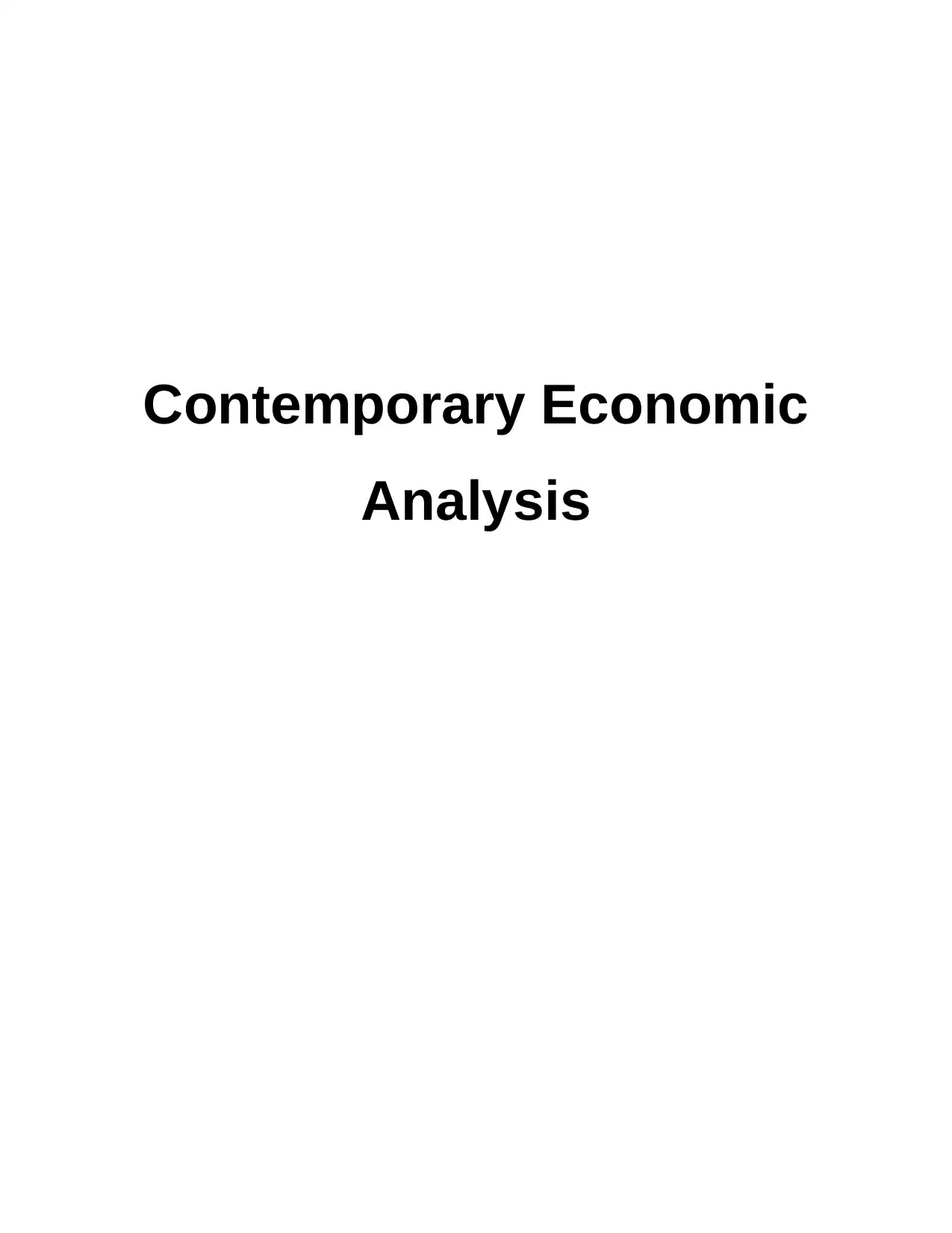
Contemporary Economic
Analysis
Analysis
Paraphrase This Document
Need a fresh take? Get an instant paraphrase of this document with our AI Paraphraser
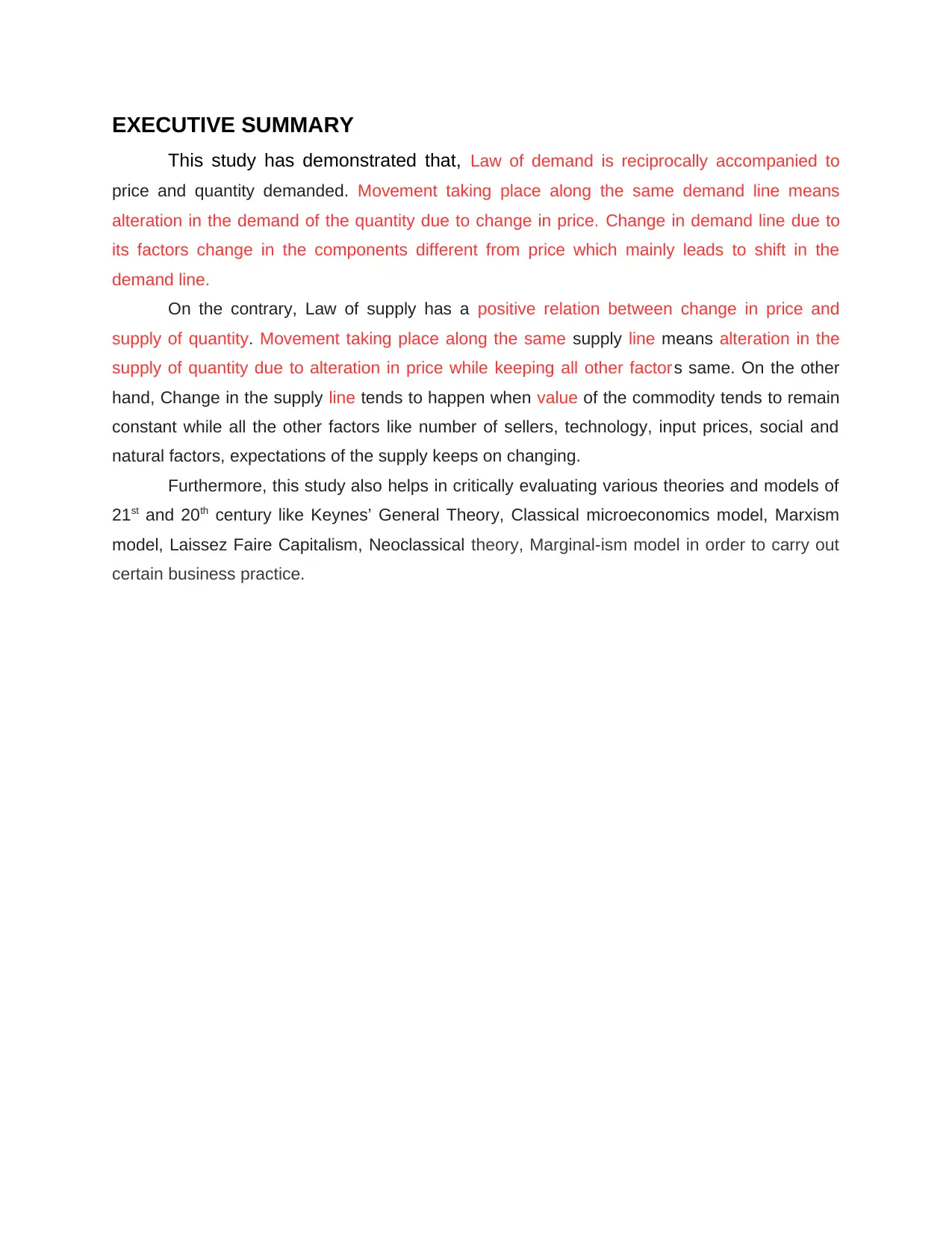
EXECUTIVE SUMMARY
This study has demonstrated that, Law of demand is reciprocally accompanied to
price and quantity demanded. Movement taking place along the same demand line means
alteration in the demand of the quantity due to change in price. Change in demand line due to
its factors change in the components different from price which mainly leads to shift in the
demand line.
On the contrary, Law of supply has a positive relation between change in price and
supply of quantity. Movement taking place along the same supply line means alteration in the
supply of quantity due to alteration in price while keeping all other factors same. On the other
hand, Change in the supply line tends to happen when value of the commodity tends to remain
constant while all the other factors like number of sellers, technology, input prices, social and
natural factors, expectations of the supply keeps on changing.
Furthermore, this study also helps in critically evaluating various theories and models of
21st and 20th century like Keynes’ General Theory, Classical microeconomics model, Marxism
model, Laissez Faire Capitalism, Neoclassical theory, Marginal-ism model in order to carry out
certain business practice.
This study has demonstrated that, Law of demand is reciprocally accompanied to
price and quantity demanded. Movement taking place along the same demand line means
alteration in the demand of the quantity due to change in price. Change in demand line due to
its factors change in the components different from price which mainly leads to shift in the
demand line.
On the contrary, Law of supply has a positive relation between change in price and
supply of quantity. Movement taking place along the same supply line means alteration in the
supply of quantity due to alteration in price while keeping all other factors same. On the other
hand, Change in the supply line tends to happen when value of the commodity tends to remain
constant while all the other factors like number of sellers, technology, input prices, social and
natural factors, expectations of the supply keeps on changing.
Furthermore, this study also helps in critically evaluating various theories and models of
21st and 20th century like Keynes’ General Theory, Classical microeconomics model, Marxism
model, Laissez Faire Capitalism, Neoclassical theory, Marginal-ism model in order to carry out
certain business practice.
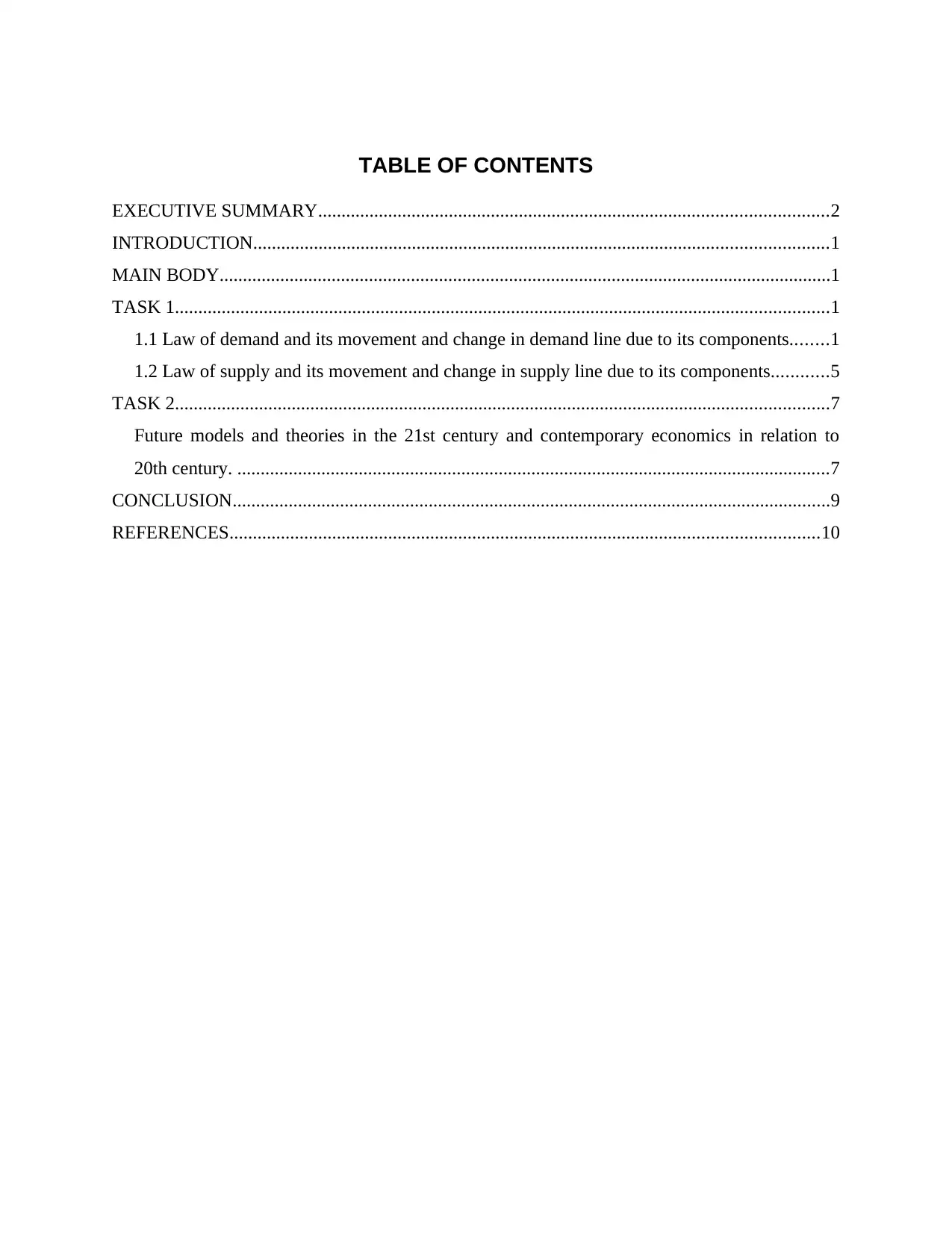
TABLE OF CONTENTS
EXECUTIVE SUMMARY.............................................................................................................2
INTRODUCTION...........................................................................................................................1
MAIN BODY...................................................................................................................................1
TASK 1............................................................................................................................................1
1.1 Law of demand and its movement and change in demand line due to its components........1
1.2 Law of supply and its movement and change in supply line due to its components............5
TASK 2............................................................................................................................................7
Future models and theories in the 21st century and contemporary economics in relation to
20th century. ...............................................................................................................................7
CONCLUSION................................................................................................................................9
REFERENCES..............................................................................................................................10
EXECUTIVE SUMMARY.............................................................................................................2
INTRODUCTION...........................................................................................................................1
MAIN BODY...................................................................................................................................1
TASK 1............................................................................................................................................1
1.1 Law of demand and its movement and change in demand line due to its components........1
1.2 Law of supply and its movement and change in supply line due to its components............5
TASK 2............................................................................................................................................7
Future models and theories in the 21st century and contemporary economics in relation to
20th century. ...............................................................................................................................7
CONCLUSION................................................................................................................................9
REFERENCES..............................................................................................................................10
⊘ This is a preview!⊘
Do you want full access?
Subscribe today to unlock all pages.

Trusted by 1+ million students worldwide
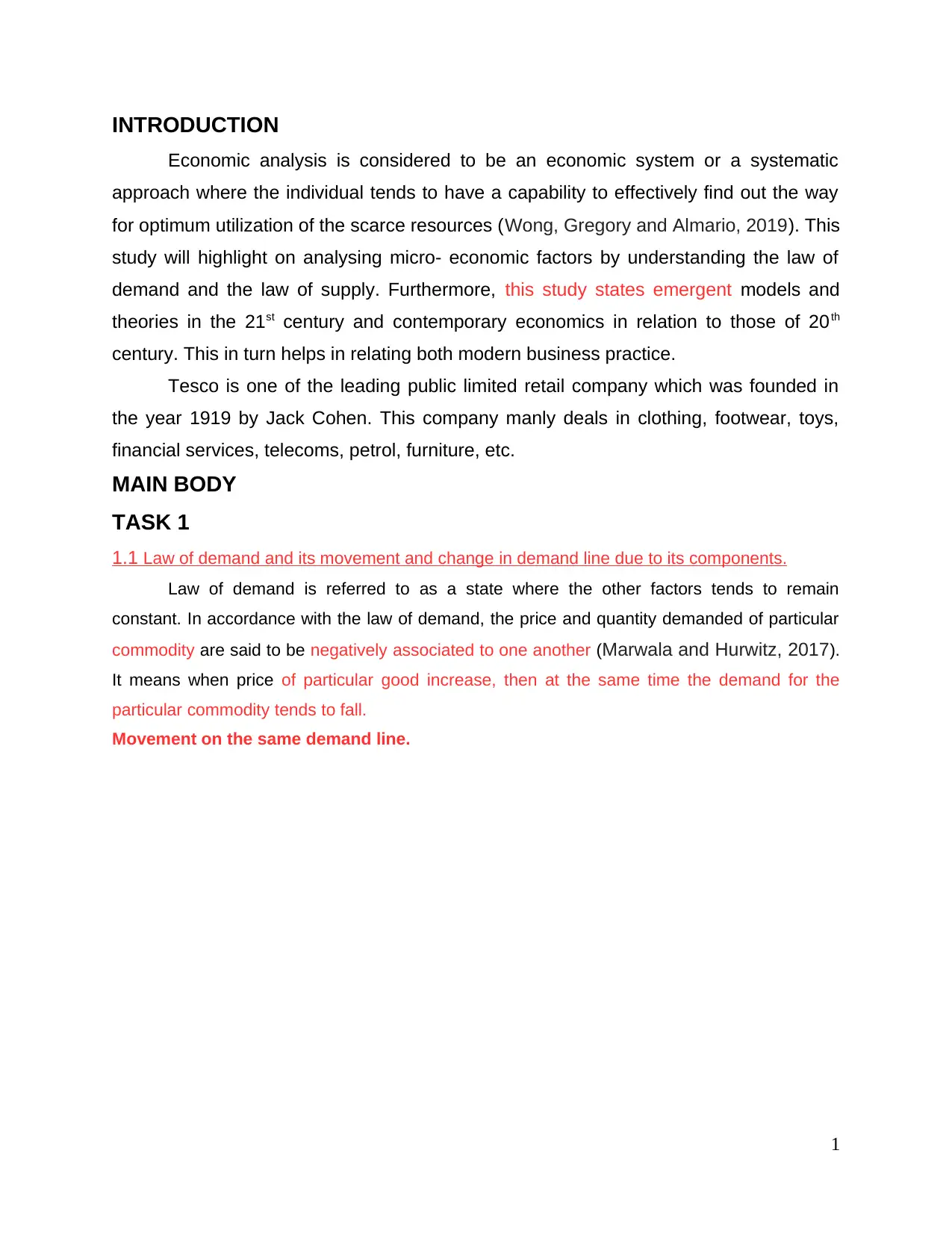
INTRODUCTION
Economic analysis is considered to be an economic system or a systematic
approach where the individual tends to have a capability to effectively find out the way
for optimum utilization of the scarce resources (Wong, Gregory and Almario, 2019). This
study will highlight on analysing micro- economic factors by understanding the law of
demand and the law of supply. Furthermore, this study states emergent models and
theories in the 21st century and contemporary economics in relation to those of 20th
century. This in turn helps in relating both modern business practice.
Tesco is one of the leading public limited retail company which was founded in
the year 1919 by Jack Cohen. This company manly deals in clothing, footwear, toys,
financial services, telecoms, petrol, furniture, etc.
MAIN BODY
TASK 1
1.1 Law of demand and its movement and change in demand line due to its components.
Law of demand is referred to as a state where the other factors tends to remain
constant. In accordance with the law of demand, the price and quantity demanded of particular
commodity are said to be negatively associated to one another (Marwala and Hurwitz, 2017).
It means when price of particular good increase, then at the same time the demand for the
particular commodity tends to fall.
Movement on the same demand line.
1
Economic analysis is considered to be an economic system or a systematic
approach where the individual tends to have a capability to effectively find out the way
for optimum utilization of the scarce resources (Wong, Gregory and Almario, 2019). This
study will highlight on analysing micro- economic factors by understanding the law of
demand and the law of supply. Furthermore, this study states emergent models and
theories in the 21st century and contemporary economics in relation to those of 20th
century. This in turn helps in relating both modern business practice.
Tesco is one of the leading public limited retail company which was founded in
the year 1919 by Jack Cohen. This company manly deals in clothing, footwear, toys,
financial services, telecoms, petrol, furniture, etc.
MAIN BODY
TASK 1
1.1 Law of demand and its movement and change in demand line due to its components.
Law of demand is referred to as a state where the other factors tends to remain
constant. In accordance with the law of demand, the price and quantity demanded of particular
commodity are said to be negatively associated to one another (Marwala and Hurwitz, 2017).
It means when price of particular good increase, then at the same time the demand for the
particular commodity tends to fall.
Movement on the same demand line.
1
Paraphrase This Document
Need a fresh take? Get an instant paraphrase of this document with our AI Paraphraser
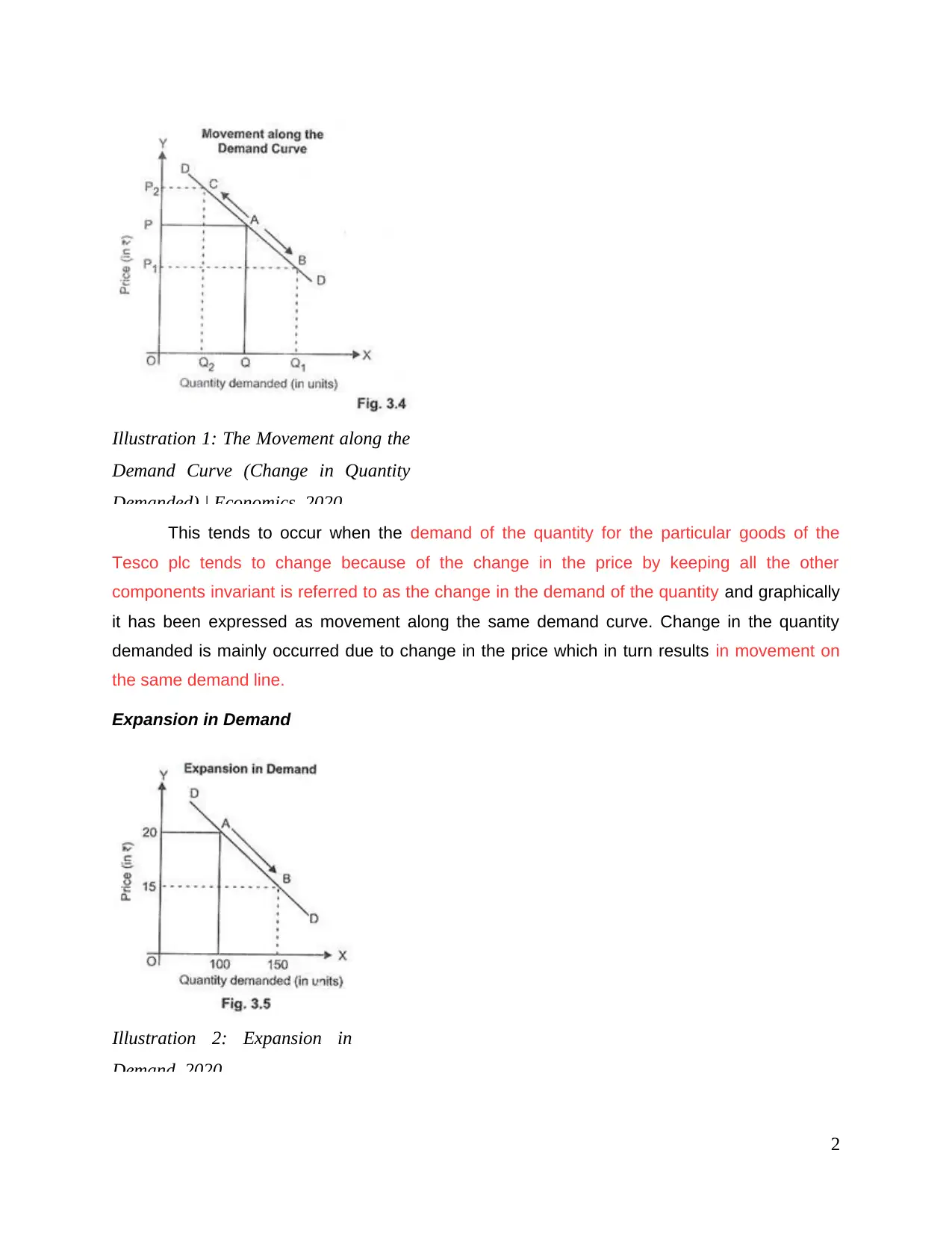
Illustration 1: The Movement along the
Demand Curve (Change in Quantity
Demanded) | Economics. 2020.
This tends to occur when the demand of the quantity for the particular goods of the
Tesco plc tends to change because of the change in the price by keeping all the other
components invariant is referred to as the change in the demand of the quantity and graphically
it has been expressed as movement along the same demand curve. Change in the quantity
demanded is mainly occurred due to change in the price which in turn results in movement on
the same demand line.
Expansion in Demand
Illustration 2: Expansion in
Demand. 2020.
2
Demand Curve (Change in Quantity
Demanded) | Economics. 2020.
This tends to occur when the demand of the quantity for the particular goods of the
Tesco plc tends to change because of the change in the price by keeping all the other
components invariant is referred to as the change in the demand of the quantity and graphically
it has been expressed as movement along the same demand curve. Change in the quantity
demanded is mainly occurred due to change in the price which in turn results in movement on
the same demand line.
Expansion in Demand
Illustration 2: Expansion in
Demand. 2020.
2
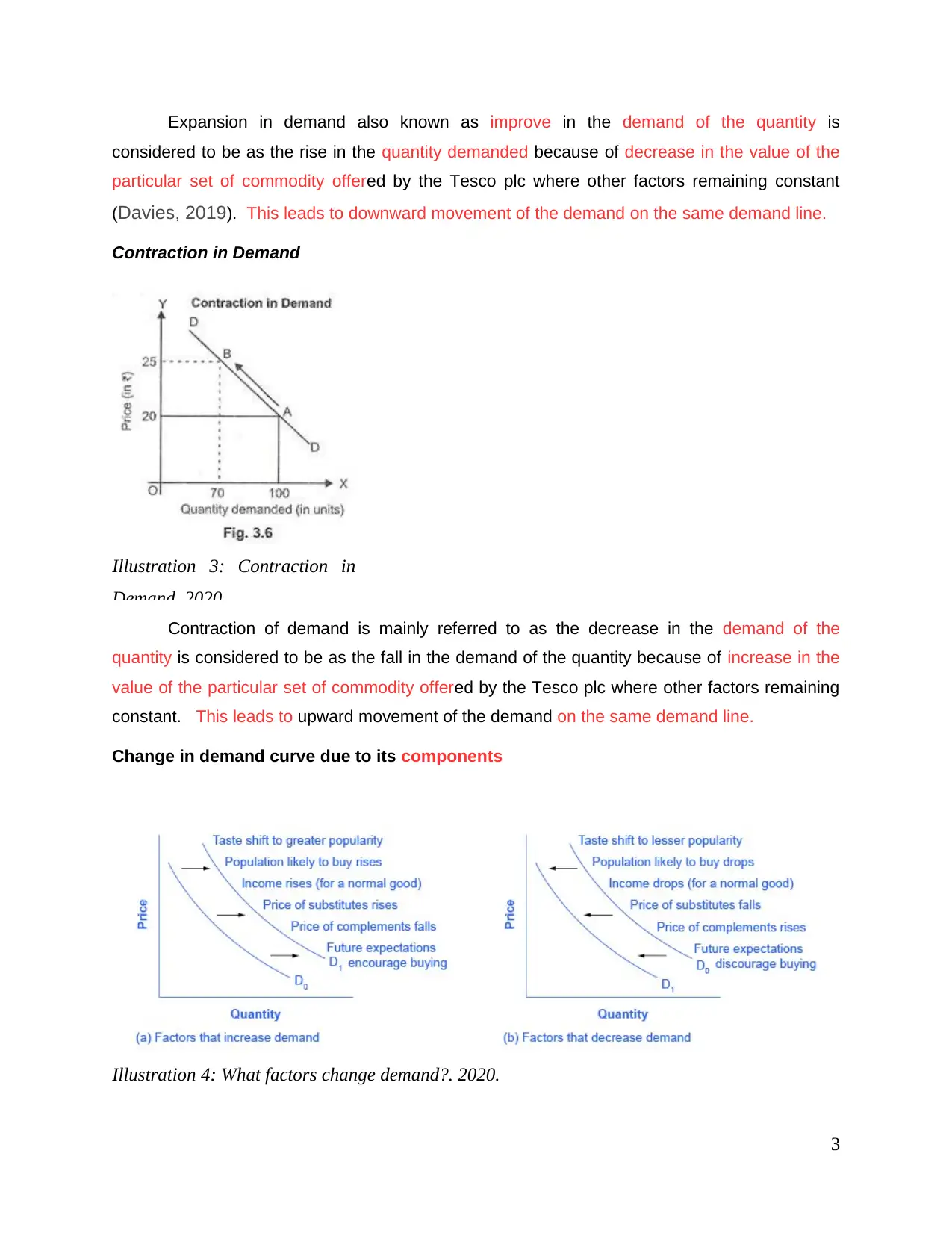
Expansion in demand also known as improve in the demand of the quantity is
considered to be as the rise in the quantity demanded because of decrease in the value of the
particular set of commodity offered by the Tesco plc where other factors remaining constant
(Davies, 2019). This leads to downward movement of the demand on the same demand line.
Contraction in Demand
Illustration 3: Contraction in
Demand. 2020.
Contraction of demand is mainly referred to as the decrease in the demand of the
quantity is considered to be as the fall in the demand of the quantity because of increase in the
value of the particular set of commodity offered by the Tesco plc where other factors remaining
constant. This leads to upward movement of the demand on the same demand line.
Change in demand curve due to its components
Illustration 4: What factors change demand?. 2020.
3
considered to be as the rise in the quantity demanded because of decrease in the value of the
particular set of commodity offered by the Tesco plc where other factors remaining constant
(Davies, 2019). This leads to downward movement of the demand on the same demand line.
Contraction in Demand
Illustration 3: Contraction in
Demand. 2020.
Contraction of demand is mainly referred to as the decrease in the demand of the
quantity is considered to be as the fall in the demand of the quantity because of increase in the
value of the particular set of commodity offered by the Tesco plc where other factors remaining
constant. This leads to upward movement of the demand on the same demand line.
Change in demand curve due to its components
Illustration 4: What factors change demand?. 2020.
3
⊘ This is a preview!⊘
Do you want full access?
Subscribe today to unlock all pages.

Trusted by 1+ million students worldwide
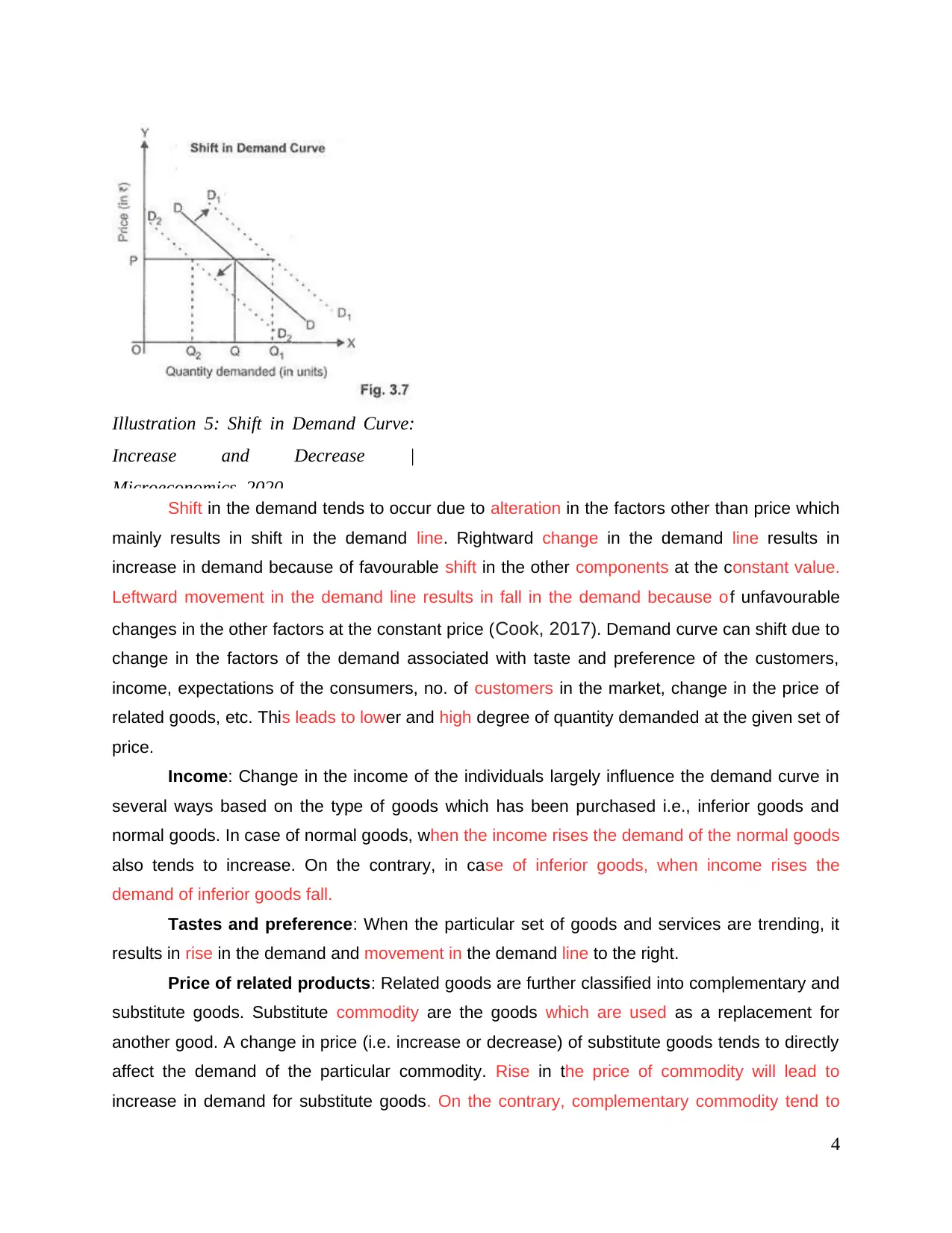
Illustration 5: Shift in Demand Curve:
Increase and Decrease |
Microeconomics. 2020.
Shift in the demand tends to occur due to alteration in the factors other than price which
mainly results in shift in the demand line. Rightward change in the demand line results in
increase in demand because of favourable shift in the other components at the constant value.
Leftward movement in the demand line results in fall in the demand because of unfavourable
changes in the other factors at the constant price (Cook, 2017). Demand curve can shift due to
change in the factors of the demand associated with taste and preference of the customers,
income, expectations of the consumers, no. of customers in the market, change in the price of
related goods, etc. This leads to lower and high degree of quantity demanded at the given set of
price.
Income: Change in the income of the individuals largely influence the demand curve in
several ways based on the type of goods which has been purchased i.e., inferior goods and
normal goods. In case of normal goods, when the income rises the demand of the normal goods
also tends to increase. On the contrary, in case of inferior goods, when income rises the
demand of inferior goods fall.
Tastes and preference: When the particular set of goods and services are trending, it
results in rise in the demand and movement in the demand line to the right.
Price of related products: Related goods are further classified into complementary and
substitute goods. Substitute commodity are the goods which are used as a replacement for
another good. A change in price (i.e. increase or decrease) of substitute goods tends to directly
affect the demand of the particular commodity. Rise in the price of commodity will lead to
increase in demand for substitute goods. On the contrary, complementary commodity tend to
4
Increase and Decrease |
Microeconomics. 2020.
Shift in the demand tends to occur due to alteration in the factors other than price which
mainly results in shift in the demand line. Rightward change in the demand line results in
increase in demand because of favourable shift in the other components at the constant value.
Leftward movement in the demand line results in fall in the demand because of unfavourable
changes in the other factors at the constant price (Cook, 2017). Demand curve can shift due to
change in the factors of the demand associated with taste and preference of the customers,
income, expectations of the consumers, no. of customers in the market, change in the price of
related goods, etc. This leads to lower and high degree of quantity demanded at the given set of
price.
Income: Change in the income of the individuals largely influence the demand curve in
several ways based on the type of goods which has been purchased i.e., inferior goods and
normal goods. In case of normal goods, when the income rises the demand of the normal goods
also tends to increase. On the contrary, in case of inferior goods, when income rises the
demand of inferior goods fall.
Tastes and preference: When the particular set of goods and services are trending, it
results in rise in the demand and movement in the demand line to the right.
Price of related products: Related goods are further classified into complementary and
substitute goods. Substitute commodity are the goods which are used as a replacement for
another good. A change in price (i.e. increase or decrease) of substitute goods tends to directly
affect the demand of the particular commodity. Rise in the price of commodity will lead to
increase in demand for substitute goods. On the contrary, complementary commodity tend to
4
Paraphrase This Document
Need a fresh take? Get an instant paraphrase of this document with our AI Paraphraser
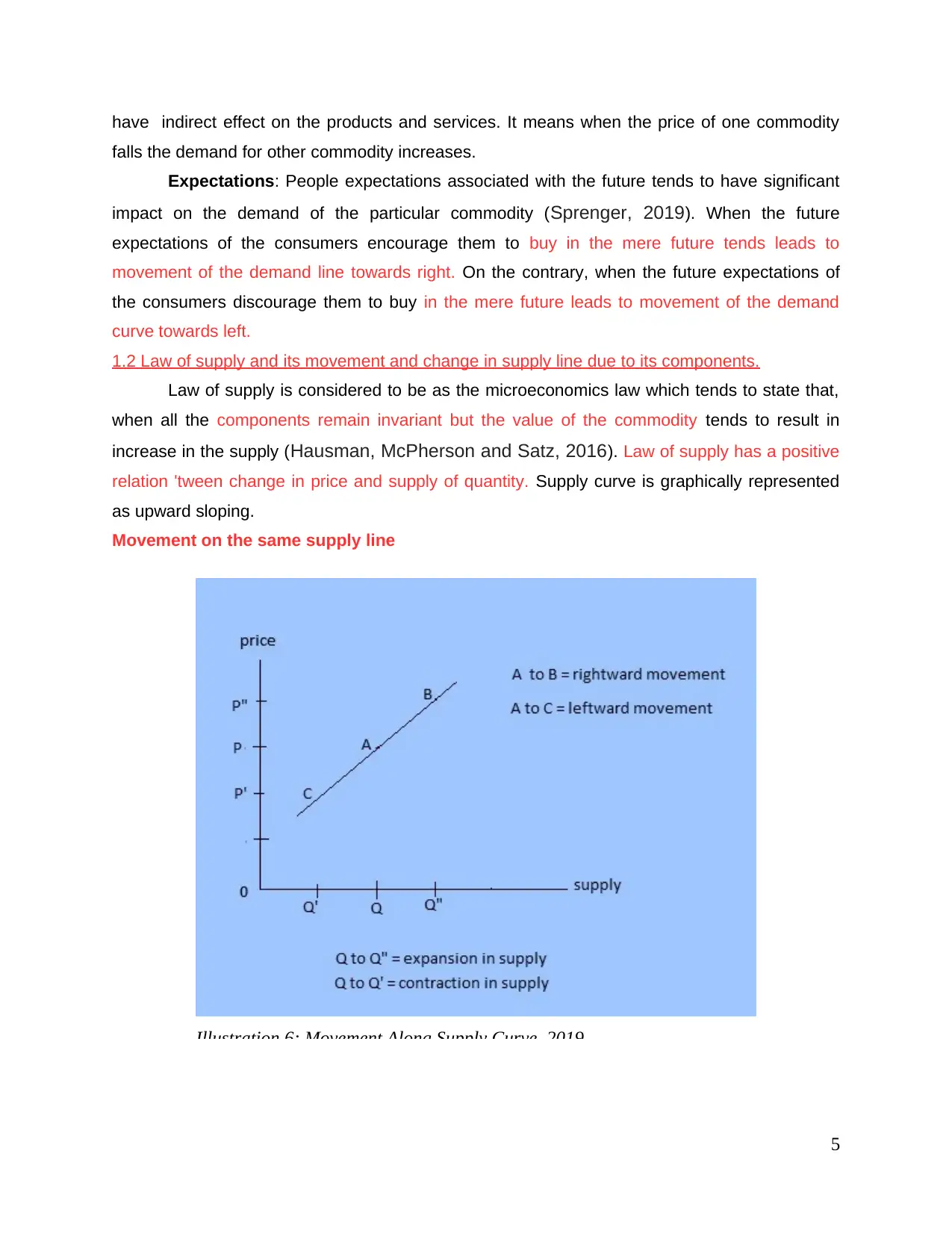
have indirect effect on the products and services. It means when the price of one commodity
falls the demand for other commodity increases.
Expectations: People expectations associated with the future tends to have significant
impact on the demand of the particular commodity (Sprenger, 2019). When the future
expectations of the consumers encourage them to buy in the mere future tends leads to
movement of the demand line towards right. On the contrary, when the future expectations of
the consumers discourage them to buy in the mere future leads to movement of the demand
curve towards left.
1.2 Law of supply and its movement and change in supply line due to its components.
Law of supply is considered to be as the microeconomics law which tends to state that,
when all the components remain invariant but the value of the commodity tends to result in
increase in the supply (Hausman, McPherson and Satz, 2016). Law of supply has a positive
relation 'tween change in price and supply of quantity. Supply curve is graphically represented
as upward sloping.
Movement on the same supply line
5
Illustration 6: Movement Along Supply Curve. 2019.
falls the demand for other commodity increases.
Expectations: People expectations associated with the future tends to have significant
impact on the demand of the particular commodity (Sprenger, 2019). When the future
expectations of the consumers encourage them to buy in the mere future tends leads to
movement of the demand line towards right. On the contrary, when the future expectations of
the consumers discourage them to buy in the mere future leads to movement of the demand
curve towards left.
1.2 Law of supply and its movement and change in supply line due to its components.
Law of supply is considered to be as the microeconomics law which tends to state that,
when all the components remain invariant but the value of the commodity tends to result in
increase in the supply (Hausman, McPherson and Satz, 2016). Law of supply has a positive
relation 'tween change in price and supply of quantity. Supply curve is graphically represented
as upward sloping.
Movement on the same supply line
5
Illustration 6: Movement Along Supply Curve. 2019.
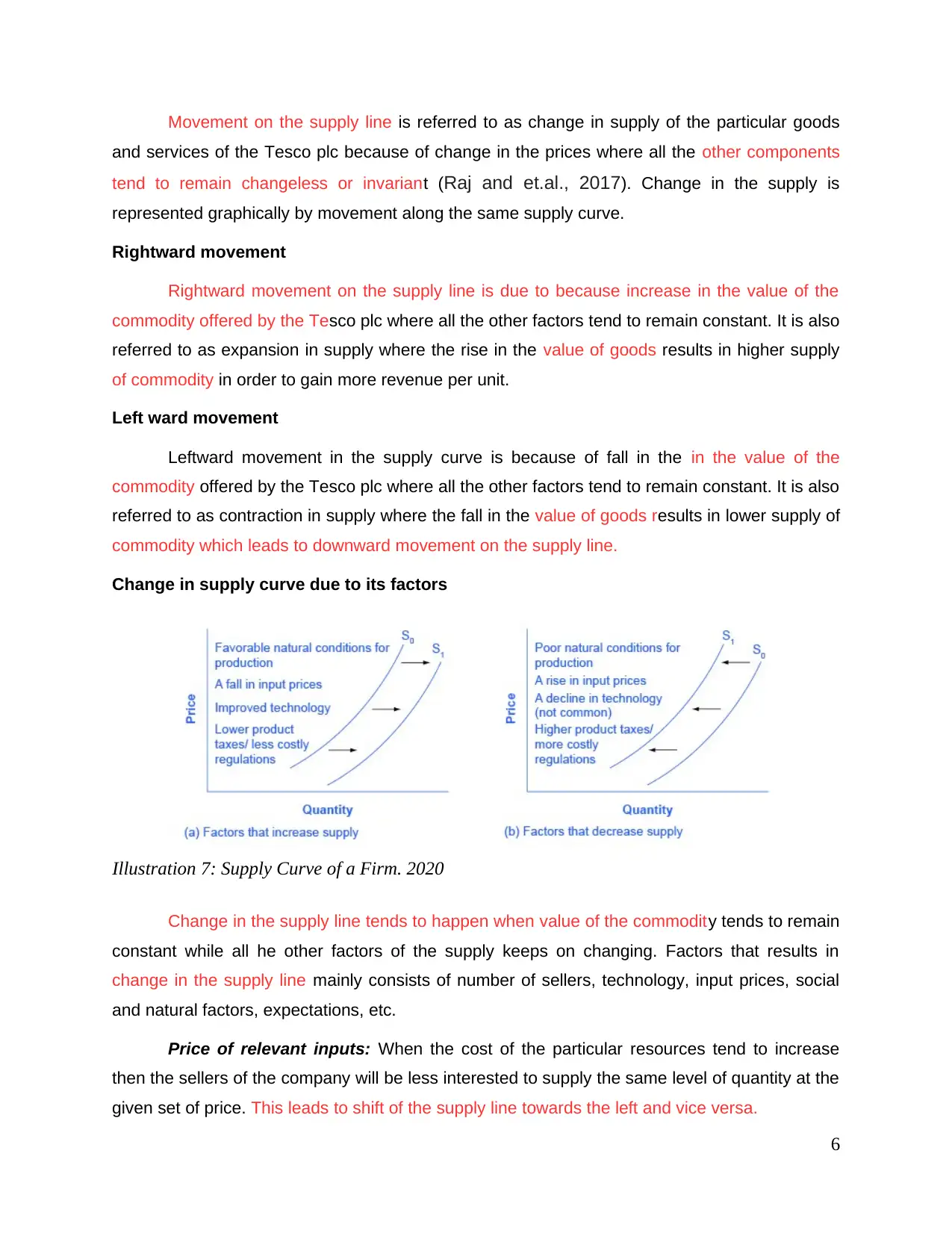
Movement on the supply line is referred to as change in supply of the particular goods
and services of the Tesco plc because of change in the prices where all the other components
tend to remain changeless or invariant (Raj and et.al., 2017). Change in the supply is
represented graphically by movement along the same supply curve.
Rightward movement
Rightward movement on the supply line is due to because increase in the value of the
commodity offered by the Tesco plc where all the other factors tend to remain constant. It is also
referred to as expansion in supply where the rise in the value of goods results in higher supply
of commodity in order to gain more revenue per unit.
Left ward movement
Leftward movement in the supply curve is because of fall in the in the value of the
commodity offered by the Tesco plc where all the other factors tend to remain constant. It is also
referred to as contraction in supply where the fall in the value of goods results in lower supply of
commodity which leads to downward movement on the supply line.
Change in supply curve due to its factors
Illustration 7: Supply Curve of a Firm. 2020
Change in the supply line tends to happen when value of the commodity tends to remain
constant while all he other factors of the supply keeps on changing. Factors that results in
change in the supply line mainly consists of number of sellers, technology, input prices, social
and natural factors, expectations, etc.
Price of relevant inputs: When the cost of the particular resources tend to increase
then the sellers of the company will be less interested to supply the same level of quantity at the
given set of price. This leads to shift of the supply line towards the left and vice versa.
6
and services of the Tesco plc because of change in the prices where all the other components
tend to remain changeless or invariant (Raj and et.al., 2017). Change in the supply is
represented graphically by movement along the same supply curve.
Rightward movement
Rightward movement on the supply line is due to because increase in the value of the
commodity offered by the Tesco plc where all the other factors tend to remain constant. It is also
referred to as expansion in supply where the rise in the value of goods results in higher supply
of commodity in order to gain more revenue per unit.
Left ward movement
Leftward movement in the supply curve is because of fall in the in the value of the
commodity offered by the Tesco plc where all the other factors tend to remain constant. It is also
referred to as contraction in supply where the fall in the value of goods results in lower supply of
commodity which leads to downward movement on the supply line.
Change in supply curve due to its factors
Illustration 7: Supply Curve of a Firm. 2020
Change in the supply line tends to happen when value of the commodity tends to remain
constant while all he other factors of the supply keeps on changing. Factors that results in
change in the supply line mainly consists of number of sellers, technology, input prices, social
and natural factors, expectations, etc.
Price of relevant inputs: When the cost of the particular resources tend to increase
then the sellers of the company will be less interested to supply the same level of quantity at the
given set of price. This leads to shift of the supply line towards the left and vice versa.
6
⊘ This is a preview!⊘
Do you want full access?
Subscribe today to unlock all pages.

Trusted by 1+ million students worldwide
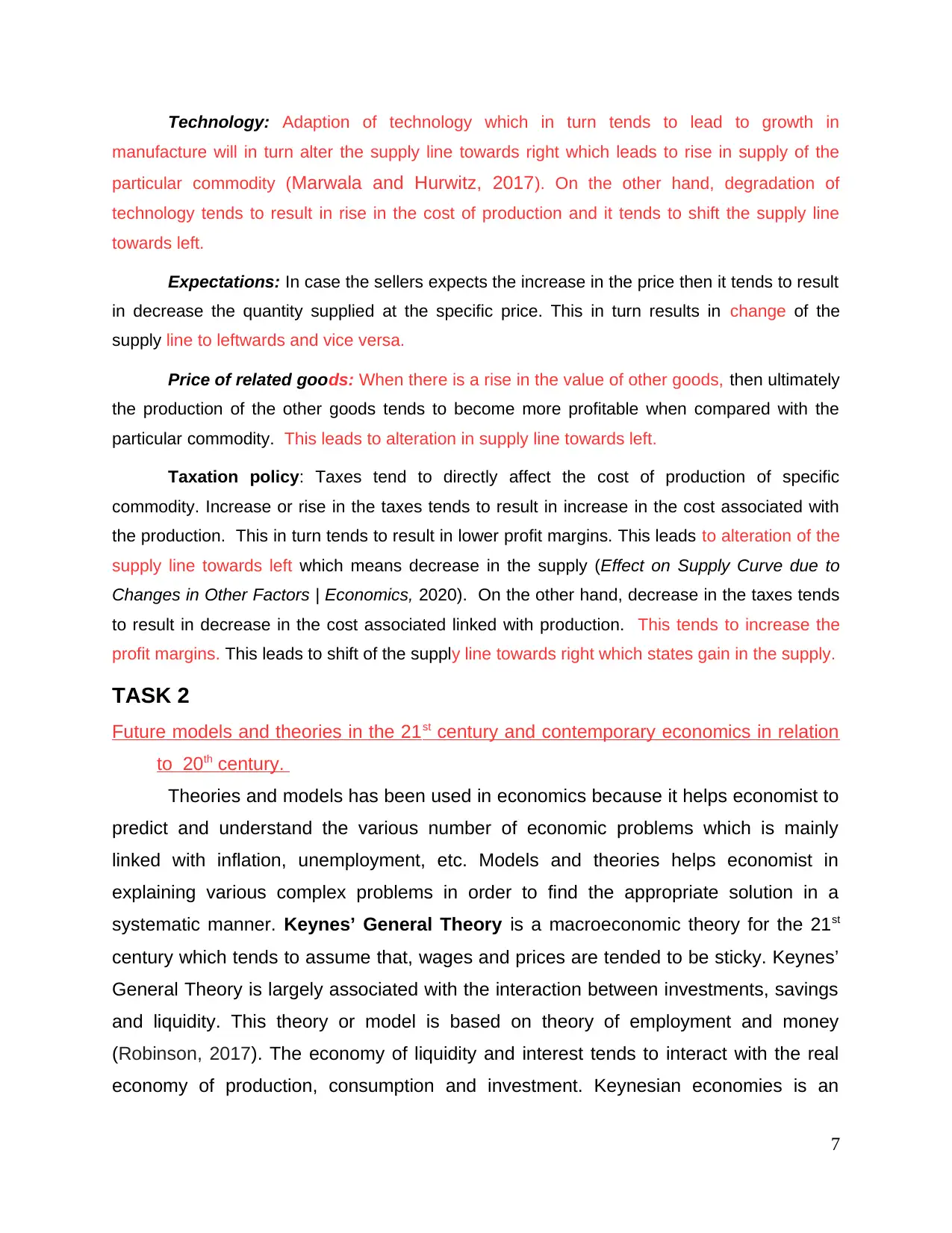
Technology: Adaption of technology which in turn tends to lead to growth in
manufacture will in turn alter the supply line towards right which leads to rise in supply of the
particular commodity (Marwala and Hurwitz, 2017). On the other hand, degradation of
technology tends to result in rise in the cost of production and it tends to shift the supply line
towards left.
Expectations: In case the sellers expects the increase in the price then it tends to result
in decrease the quantity supplied at the specific price. This in turn results in change of the
supply line to leftwards and vice versa.
Price of related goods: When there is a rise in the value of other goods, then ultimately
the production of the other goods tends to become more profitable when compared with the
particular commodity. This leads to alteration in supply line towards left.
Taxation policy: Taxes tend to directly affect the cost of production of specific
commodity. Increase or rise in the taxes tends to result in increase in the cost associated with
the production. This in turn tends to result in lower profit margins. This leads to alteration of the
supply line towards left which means decrease in the supply (Effect on Supply Curve due to
Changes in Other Factors | Economics, 2020). On the other hand, decrease in the taxes tends
to result in decrease in the cost associated linked with production. This tends to increase the
profit margins. This leads to shift of the supply line towards right which states gain in the supply.
TASK 2
Future models and theories in the 21st century and contemporary economics in relation
to 20th century.
Theories and models has been used in economics because it helps economist to
predict and understand the various number of economic problems which is mainly
linked with inflation, unemployment, etc. Models and theories helps economist in
explaining various complex problems in order to find the appropriate solution in a
systematic manner. Keynes’ General Theory is a macroeconomic theory for the 21st
century which tends to assume that, wages and prices are tended to be sticky. Keynes’
General Theory is largely associated with the interaction between investments, savings
and liquidity. This theory or model is based on theory of employment and money
(Robinson, 2017). The economy of liquidity and interest tends to interact with the real
economy of production, consumption and investment. Keynesian economies is an
7
manufacture will in turn alter the supply line towards right which leads to rise in supply of the
particular commodity (Marwala and Hurwitz, 2017). On the other hand, degradation of
technology tends to result in rise in the cost of production and it tends to shift the supply line
towards left.
Expectations: In case the sellers expects the increase in the price then it tends to result
in decrease the quantity supplied at the specific price. This in turn results in change of the
supply line to leftwards and vice versa.
Price of related goods: When there is a rise in the value of other goods, then ultimately
the production of the other goods tends to become more profitable when compared with the
particular commodity. This leads to alteration in supply line towards left.
Taxation policy: Taxes tend to directly affect the cost of production of specific
commodity. Increase or rise in the taxes tends to result in increase in the cost associated with
the production. This in turn tends to result in lower profit margins. This leads to alteration of the
supply line towards left which means decrease in the supply (Effect on Supply Curve due to
Changes in Other Factors | Economics, 2020). On the other hand, decrease in the taxes tends
to result in decrease in the cost associated linked with production. This tends to increase the
profit margins. This leads to shift of the supply line towards right which states gain in the supply.
TASK 2
Future models and theories in the 21st century and contemporary economics in relation
to 20th century.
Theories and models has been used in economics because it helps economist to
predict and understand the various number of economic problems which is mainly
linked with inflation, unemployment, etc. Models and theories helps economist in
explaining various complex problems in order to find the appropriate solution in a
systematic manner. Keynes’ General Theory is a macroeconomic theory for the 21st
century which tends to assume that, wages and prices are tended to be sticky. Keynes’
General Theory is largely associated with the interaction between investments, savings
and liquidity. This theory or model is based on theory of employment and money
(Robinson, 2017). The economy of liquidity and interest tends to interact with the real
economy of production, consumption and investment. Keynesian economies is an
7
Paraphrase This Document
Need a fresh take? Get an instant paraphrase of this document with our AI Paraphraser
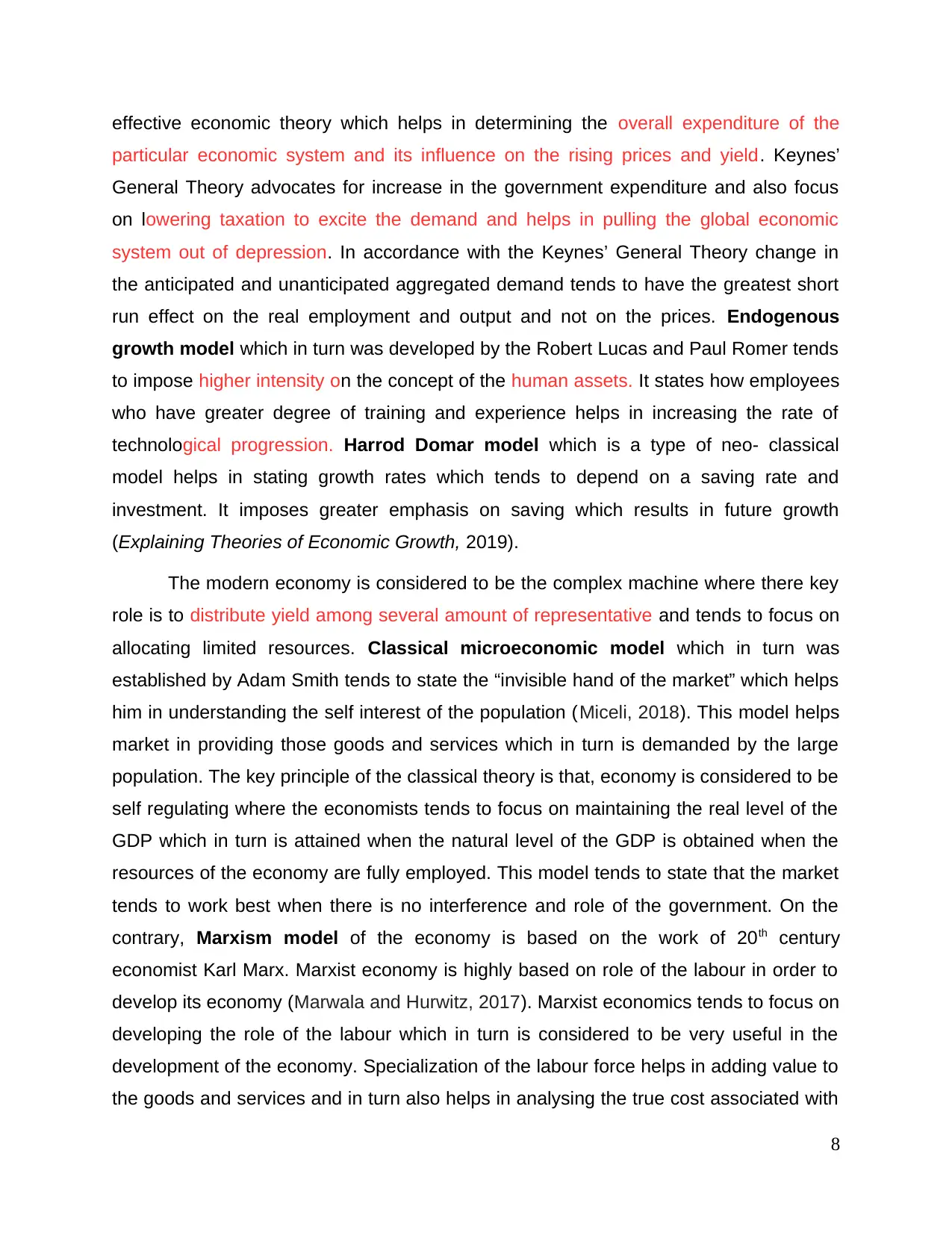
effective economic theory which helps in determining the overall expenditure of the
particular economic system and its influence on the rising prices and yield. Keynes’
General Theory advocates for increase in the government expenditure and also focus
on lowering taxation to excite the demand and helps in pulling the global economic
system out of depression. In accordance with the Keynes’ General Theory change in
the anticipated and unanticipated aggregated demand tends to have the greatest short
run effect on the real employment and output and not on the prices. Endogenous
growth model which in turn was developed by the Robert Lucas and Paul Romer tends
to impose higher intensity on the concept of the human assets. It states how employees
who have greater degree of training and experience helps in increasing the rate of
technological progression. Harrod Domar model which is a type of neo- classical
model helps in stating growth rates which tends to depend on a saving rate and
investment. It imposes greater emphasis on saving which results in future growth
(Explaining Theories of Economic Growth, 2019).
The modern economy is considered to be the complex machine where there key
role is to distribute yield among several amount of representative and tends to focus on
allocating limited resources. Classical microeconomic model which in turn was
established by Adam Smith tends to state the “invisible hand of the market” which helps
him in understanding the self interest of the population (Miceli, 2018). This model helps
market in providing those goods and services which in turn is demanded by the large
population. The key principle of the classical theory is that, economy is considered to be
self regulating where the economists tends to focus on maintaining the real level of the
GDP which in turn is attained when the natural level of the GDP is obtained when the
resources of the economy are fully employed. This model tends to state that the market
tends to work best when there is no interference and role of the government. On the
contrary, Marxism model of the economy is based on the work of 20th century
economist Karl Marx. Marxist economy is highly based on role of the labour in order to
develop its economy (Marwala and Hurwitz, 2017). Marxist economics tends to focus on
developing the role of the labour which in turn is considered to be very useful in the
development of the economy. Specialization of the labour force helps in adding value to
the goods and services and in turn also helps in analysing the true cost associated with
8
particular economic system and its influence on the rising prices and yield. Keynes’
General Theory advocates for increase in the government expenditure and also focus
on lowering taxation to excite the demand and helps in pulling the global economic
system out of depression. In accordance with the Keynes’ General Theory change in
the anticipated and unanticipated aggregated demand tends to have the greatest short
run effect on the real employment and output and not on the prices. Endogenous
growth model which in turn was developed by the Robert Lucas and Paul Romer tends
to impose higher intensity on the concept of the human assets. It states how employees
who have greater degree of training and experience helps in increasing the rate of
technological progression. Harrod Domar model which is a type of neo- classical
model helps in stating growth rates which tends to depend on a saving rate and
investment. It imposes greater emphasis on saving which results in future growth
(Explaining Theories of Economic Growth, 2019).
The modern economy is considered to be the complex machine where there key
role is to distribute yield among several amount of representative and tends to focus on
allocating limited resources. Classical microeconomic model which in turn was
established by Adam Smith tends to state the “invisible hand of the market” which helps
him in understanding the self interest of the population (Miceli, 2018). This model helps
market in providing those goods and services which in turn is demanded by the large
population. The key principle of the classical theory is that, economy is considered to be
self regulating where the economists tends to focus on maintaining the real level of the
GDP which in turn is attained when the natural level of the GDP is obtained when the
resources of the economy are fully employed. This model tends to state that the market
tends to work best when there is no interference and role of the government. On the
contrary, Marxism model of the economy is based on the work of 20th century
economist Karl Marx. Marxist economy is highly based on role of the labour in order to
develop its economy (Marwala and Hurwitz, 2017). Marxist economics tends to focus on
developing the role of the labour which in turn is considered to be very useful in the
development of the economy. Specialization of the labour force helps in adding value to
the goods and services and in turn also helps in analysing the true cost associated with
8
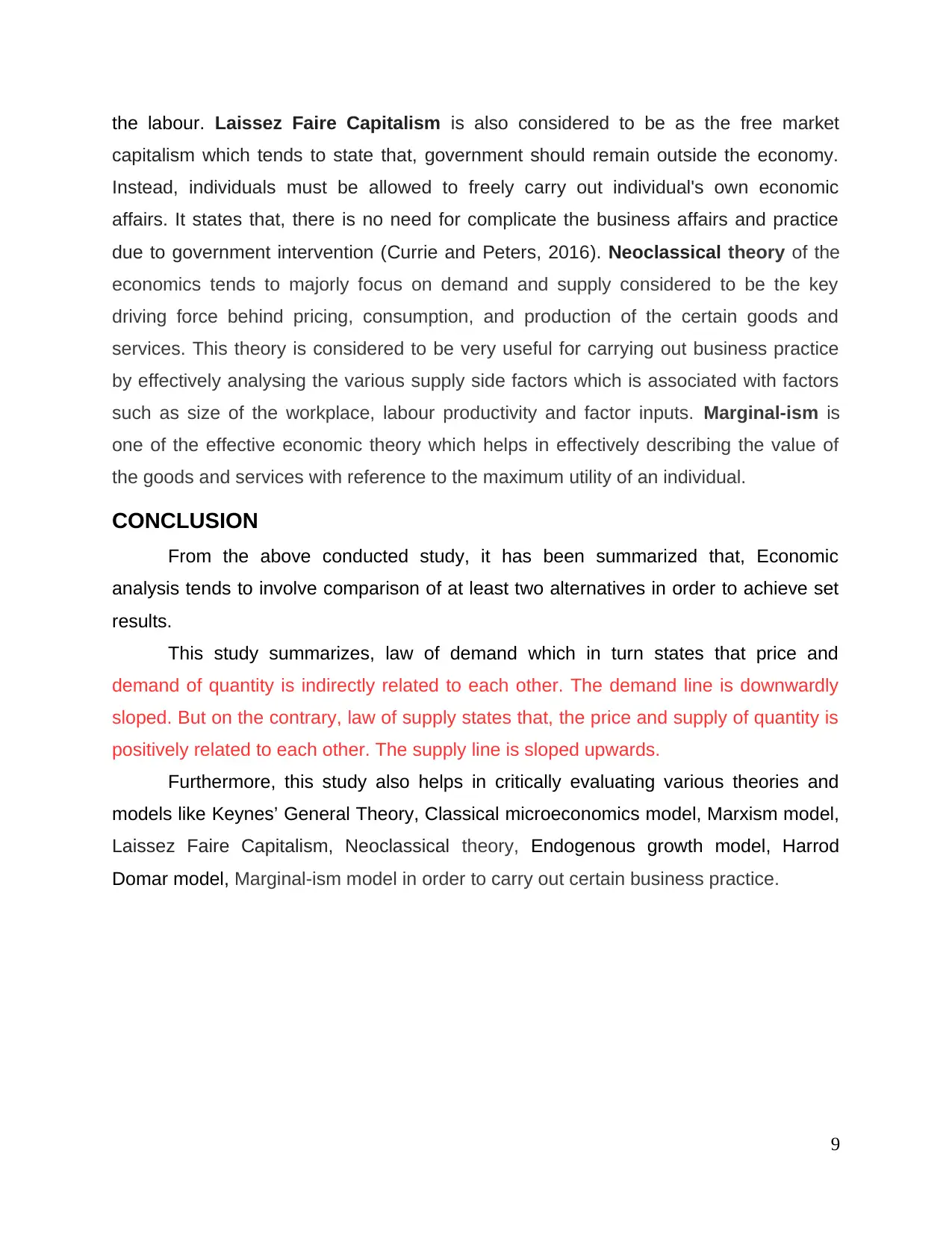
the labour. Laissez Faire Capitalism is also considered to be as the free market
capitalism which tends to state that, government should remain outside the economy.
Instead, individuals must be allowed to freely carry out individual's own economic
affairs. It states that, there is no need for complicate the business affairs and practice
due to government intervention (Currie and Peters, 2016). Neoclassical theory of the
economics tends to majorly focus on demand and supply considered to be the key
driving force behind pricing, consumption, and production of the certain goods and
services. This theory is considered to be very useful for carrying out business practice
by effectively analysing the various supply side factors which is associated with factors
such as size of the workplace, labour productivity and factor inputs. Marginal-ism is
one of the effective economic theory which helps in effectively describing the value of
the goods and services with reference to the maximum utility of an individual.
CONCLUSION
From the above conducted study, it has been summarized that, Economic
analysis tends to involve comparison of at least two alternatives in order to achieve set
results.
This study summarizes, law of demand which in turn states that price and
demand of quantity is indirectly related to each other. The demand line is downwardly
sloped. But on the contrary, law of supply states that, the price and supply of quantity is
positively related to each other. The supply line is sloped upwards.
Furthermore, this study also helps in critically evaluating various theories and
models like Keynes’ General Theory, Classical microeconomics model, Marxism model,
Laissez Faire Capitalism, Neoclassical theory, Endogenous growth model, Harrod
Domar model, Marginal-ism model in order to carry out certain business practice.
9
capitalism which tends to state that, government should remain outside the economy.
Instead, individuals must be allowed to freely carry out individual's own economic
affairs. It states that, there is no need for complicate the business affairs and practice
due to government intervention (Currie and Peters, 2016). Neoclassical theory of the
economics tends to majorly focus on demand and supply considered to be the key
driving force behind pricing, consumption, and production of the certain goods and
services. This theory is considered to be very useful for carrying out business practice
by effectively analysing the various supply side factors which is associated with factors
such as size of the workplace, labour productivity and factor inputs. Marginal-ism is
one of the effective economic theory which helps in effectively describing the value of
the goods and services with reference to the maximum utility of an individual.
CONCLUSION
From the above conducted study, it has been summarized that, Economic
analysis tends to involve comparison of at least two alternatives in order to achieve set
results.
This study summarizes, law of demand which in turn states that price and
demand of quantity is indirectly related to each other. The demand line is downwardly
sloped. But on the contrary, law of supply states that, the price and supply of quantity is
positively related to each other. The supply line is sloped upwards.
Furthermore, this study also helps in critically evaluating various theories and
models like Keynes’ General Theory, Classical microeconomics model, Marxism model,
Laissez Faire Capitalism, Neoclassical theory, Endogenous growth model, Harrod
Domar model, Marginal-ism model in order to carry out certain business practice.
9
⊘ This is a preview!⊘
Do you want full access?
Subscribe today to unlock all pages.

Trusted by 1+ million students worldwide
1 out of 14
Related Documents
Your All-in-One AI-Powered Toolkit for Academic Success.
+13062052269
info@desklib.com
Available 24*7 on WhatsApp / Email
![[object Object]](/_next/static/media/star-bottom.7253800d.svg)
Unlock your academic potential
Copyright © 2020–2025 A2Z Services. All Rights Reserved. Developed and managed by ZUCOL.


